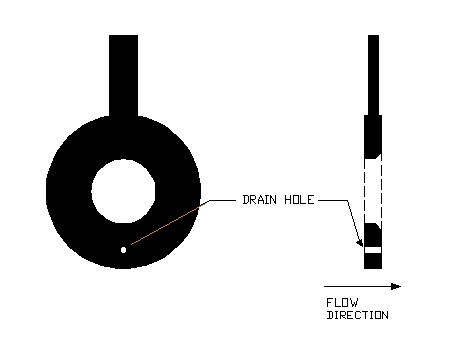In this article, you will learn the purpose of the orifice plate drain hole and the vent hole.
A drain hole is a small hole that is provided in the lower region of the orifice plate.
A drain hole is required in gas flow service where liquid entrapment may occur.
Drain hole size could affect the accuracy of flow measurement.
However, if the diameter of the drain hole is less than 10% of the orifice bore, then the unmeasured flow is less than 1% of the total flow.
A drain hole is not recommended in dirty fluid service or slurries as the hole could be plugged.
In this application, the use of an eccentric orifice plate becomes an alternative.

The vent hole is a small hole that is provided in the upper region of the orifice plate.
The vent hole is required in liquid flow service where gas entrainment may occur.
Vent hole size could affect the accuracy of flow measurement.
However, if the diameter of the vent hole is less than 10% of the orifice bore, then the unmeasured flow is less than 1% of the total flow.
The vent hole is not recommended in dirty fluid service or slurries as the hole could be plugged.
In this application, the use of an eccentric orifice plate becomes an alternative.
If you liked this article, then please subscribe to our YouTube Channel for Instrumentation, Electrical, PLC, and SCADA video tutorials.
You can also follow us on Facebook and Twitter to receive daily updates.
Read Next:
Rotating equipment packages such as pumps, compressors, turbines need the lube oil consoles for their…
This article explains how to blink lights in ladder logic with a detailed explanation video…
In this article, a simple example will teach you the conversion from Boolean algebra to…
In this article, you will learn the PLC cooking timer example for kitchen automation using…
Learn an example PLC program to control a pump based on level sensors using ladder…
In the PLC timer application for security camera recording, when motion is detected then camera…
View Comments
Your statement regarding decrease in accuracy due to drain and vent hole is not correct.There is no change in accuracy as it is taken care during orrifice design
We have orifice , DP range : 0-2500 MMWC and flow range 0-250 M3/Hr. Can we used it for measurement of 0-10 M3/Hr. is it impact on accuracy of measurement ?
You cannot unless you want to sacrifice accuracy.
A basic orifice gives a turndown ratio of 1:3 i.e for your case you can measure 83 m3/hr with an accuracy below ±0.5 %.
However, in order to measure 10 m3/hr, you need to install a 2nd and 3rd DP transmitters in parallel on same orifice by Tee joint to measure flow ranges of 28 to 84 m3/hr (Tx2) and 10 to 30 m3/hr to maintain flow accuracy of ±0.5% throughout measuring range